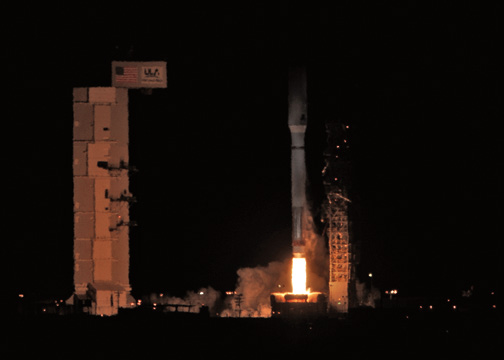Space is fundamental to the economy, the military and the way of life in the United States and officials must continue to guard against challenges in the domain from adversaries, the commander of Air Force Space Command said on January 8th, 2014, to students at George Washington University in Washington DC.

A United Launch Alliance Atlas V rocket carrying a National Reconnaissance Office payload launches from Vandenberg Air Force Base on December 5, 2013, from Space Launch Complex-3 by Team Vandenberg. U.S. Air Force photo/Michael Peterson.
General William Shelton shared with students at George Washington University some of his worries and concerns regarding space defense for our nation.
In the past 60 years, space has grown from a domain with a lone satellite beeping across the heavens to a $300 billion economic engine.
“The advent of space systems has allowed citizens and governments to engage routinely in the world around them, communicate at the speed of light and to tap sources of information previously unavailable to them,” Shelton said.
“Satellites are now essential parts of the 21st century way of life for all nations. Weather forecasting, precise navigation, instant communications and many other capabilities tie space to Earth.
“These are incredibly important during crises. The death tolls from Hurricane Katrina in 2005 and the Japanese tsunami in 2011 would have been even higher, had not satellite surveillance and communications been available,” he said.
Space has also changed the military. “In all of recorded history, when armies met on the battle field, they fought for the coveted high ground because of the obvious advantage it gave them over the adversary,” Shelton said. “Later, balloons performed that function and even later, airplanes were used as observation platforms.”
“Space is the ultimate high ground,” he said.
Shelton’s Air Force Space Command has a global mission with global responsibilities that reach all corners of the planet and up to 23,000 miles in space and geosynchronous orbit. “We get space-derived information to all sorts of users, including the military operators of our nation’s Army, Air Force, Navy and Marines—those who rely on timely and accurate data,” he said.
Intelligence, logistics and other operationally relevant data flow seamlessly to the front lines in Afghanistan as well as to other parts of the world where U.S. forces are operating.
“I can’t think of a single military operation across the full spectrum, from humanitarian relief operations all the way to major combat operations, that doesn’t somehow depend on space for mission success,” Shelton said. “But frankly, this dependence on space has also become quite a bit of a double-edged sword. Our potential adversaries have been going to school on us during these many years of combat operations.”
Adversaries are mimicking American procedures and looking for chinks in American armor,” the general said. “More concerning, as they’ve watched us, we’ve watched them develop systems to challenge our advantages in space,” he said.
“Because space launch is so expensive, we loaded as much as we could onto our satellites—multiple missions, multiple payloads, “ Shelton said. “After all, we were operating in a relatively peaceful sanctuary in space.”
Not today.
“As I look at the next 20 years in space, we have a difficult, up-hill climb ahead of us,” he said. “I equate this to the difficulty of turning the Queen Mary. You send the rudder a command and the delayed response tries your patience.”
To sustain space services, the United States must consider architectural alternatives for future satellite constellations.
“These alternatives must balance required capability, affordability and resilience,” he said. “There are many options that we’re actively studying right now. The notion of disaggregation is one. And what we mean by this is moving away from the multiple payload, big satellite construct into a less complex satellite architecture with multiple components.”
Distributing space payloads across multiple satellite platforms increases U.S. resiliency. “At a minimum, it complicates our adversaries’ targeting calculus,” he said.


